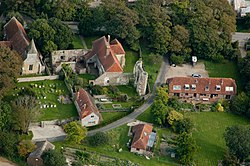Wilmington, Sussex
| Wilmington | |
| Sussex | |
|---|---|
 The ruins of Wilmington Priory | |
| Location | |
| Location: | 0.192,/zoom=13 50.818, 0.192 |
| Data | |
| Local Government | |
Wilmington is a small village in Sussex, nestled beneath the scarp of the South Downs about six miles north-west of Eastbourne. To the west is Folkington.
The village has a parish church, St Mary and St Peter.[1] adjoining it are the ruins of the 12th-century Wilmington Priory.
The name 'Wilmington' is first attested in the Domesday Book of 1086, where it appears as Wineltone and Wilminte. It appears as Wilmetun in 1212 in the Book of Fees. The name means 'the town or settlement of Wighelm's or Wilhelm's people'.[2]
About the village
The most famous sight near the village is the Long Man of Wilmington, a giant hill figure carved into the chalk of the South Downs escarpment here.
The local public house is The Giant's Rest, after the Long Man.
The Wishing Well Tea Gardens are some of the oldest in Sussex, established around 1900. The hotel Crossways is an archetypal Georgian brick and stone house, once home to the parents of the revolutionary culinary writer, Elizabeth David.
Pictures
{commons|Wilmington, East Sussex}}
 |
 |
 |
References
- ↑ Details and photographs of the church
- ↑ Ekwall, Eilert, The Concise Oxford Dictionary of English Place-Names. Oxford, Oxford University Press, 4th edition, 1960. p. 521 ISBN 0198691033